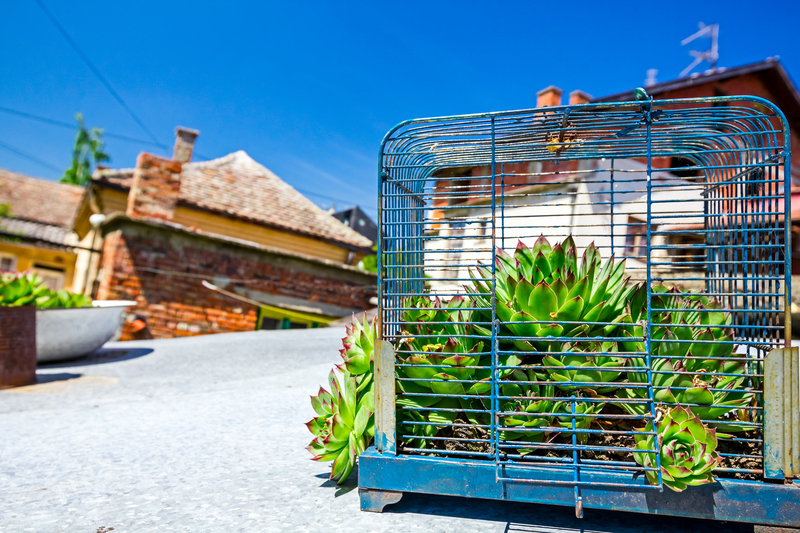Step-by-Step to a Thriving Herb Garden
Posted on 30/06/2025
Step-by-Step to a Thriving Herb Garden: The Ultimate Guide
Imagine stepping into your backyard or onto your balcony and plucking fresh basil, mint, or rosemary straight from your very own thriving herb garden. Whether you're a seasoned gardener or a complete beginner, growing your own herbs adds vibrant flavors to meals, beautiful greenery to your space, and holistic benefits to your lifestyle. In this comprehensive guide, we'll walk you--step by step--through the process of creating and nurturing a flourishing herb garden that will reward you for seasons to come.

Why Grow Your Own Herb Garden?
- Freshness: Herbs lose flavor rapidly after harvest. Home-grown herbs taste stronger and fresher.
- Convenience: Snip a sprig when you need it--no need for last-minute grocery runs.
- Cost-effective: A packet of seeds can yield many times as much as a single store-bought bunch.
- Aesthetic appeal: Herbs add beauty, color, and fragrance indoors or outdoors.
- Healthy living: Many herbs offer medicinal and health benefits beyond their culinary uses.
Ready to transform a small piece of your home into a lush oasis? Let's begin our step-by-step guide to a thriving herb garden.
1. Planning Your Herb Garden
Choosing the Right Location
Where you place your herb garden is crucial to its success. Most herbs need at least 6 hours of direct sunlight per day. Southern or western-facing windowsills, balconies, patios, or garden beds are ideal.
- Outdoor Gardens: Look for well-drained soil and an accessible spot.
- Container Herbs: If space is limited, pots on windowsills, decks, or even hanging baskets can work wonders.
Pro Tip: If you lack sun exposure, consider using grow lights for indoor herb gardens.
Selecting Your Herbs
Start with easy-to-grow herbs for beginners:
- Basil
- Mint
- Parsley
- Chives
- Cilantro
- Oregano
- Rosemary
- Thyme
Think about what you love to cook, climate compatibility, and personal taste. Research each herb's specific needs.
Designing Your Layout
Group herbs by their watering and sunlight needs. For example:
- Moisture Lovers: Basil, parsley, cilantro--plant together
- Drought-tolerant: Rosemary, thyme, oregano--group these
Select pots with adequate drainage. Mix tall, cascading, and fill-in varieties for an appealing, balanced look.
2. Preparing the Soil
Soil Quality Matters
Herb growth begins with the right soil. For garden beds, enrich the earth with organic compost. For containers, use a high-quality potting mix with added compost and perlite for drainage.
- pH Level: Most herbs thrive in slightly acidic to neutral soil (pH 6-7).
- Drainage: Ensure pots have holes, and beds are free from pooling water.
Tip: Add a bit of sand or gravel to potting mixes for Mediterranean herbs like thyme and rosemary.
3. Planting Your Herbs: Seeds vs. Transplants
Decide whether to start from seed or buy young herb plants (transplants).
- Seeds: Cheaper and offer more variety. Start indoors 6-8 weeks before last frost or sow directly outdoors after frost danger passes.
- Transplants: Easier and faster results. Perfect for beginners seeking a "head start".
How to Plant Step-by-Step
-
Read Seed Packets:
- Follow depth and spacing guidelines for each herb.
-
Prepare the Soil:
- Loosen the soil and mix in organic matter.
-
Plant Seeds or Transplants:
- Press seeds gently into soil and cover lightly; or pot/bed transplants at the same soil depth as in their original pot.
-
Water Gently:
- Use a fine spray to avoid disturbing seeds.
-
Label Varieties:
- Use waterproof markers or plant tags so you remember which is which!
4. Caring for Your Herb Garden
Watering Techniques
Herbs generally prefer consistent moisture without being waterlogged.
- Mini-Gardens/Containers: May need daily water in hot weather.
- Outdoor Beds: Water deeply but let the soil dry out slightly between waterings.
Use your finger to check soil moisture 1 inch down--if dry, it's time to water.
Fertilizing
Herbs do best with minimal fertilization--too much can make them less flavorful.
- Use balanced, organic liquid fertilizer every 4-6 weeks during growing season.
- Add compost annually to outdoor beds.
Pinching and Pruning
Regular harvesting encourages fuller, bushier growth. Pinch off flower buds, as flowering can make most herbs taste bitter.
- Basil: Pinch off the top two sets of leaves regularly for a bushier plant.
- Mint: Trim often to prevent its invasive spread.
- Woody herbs (Rosemary/Thyme): Harvest by snipping sprigs as needed.
Pest and Disease Management
Most herbs are hardy but keep an eye out for aphids, spider mites, and fungal diseases.
- Inspect regularly and remove pests by hand or with a gentle water spray.
- Encourage predators like ladybugs and lacewings to your garden.
- Avoid overwatering--most problems stem from excessive moisture.
5. Harvesting and Using Your Herbs
When and How to Harvest
- Best Time: In the morning, after dew has dried and before the sun is too strong.
- Snip just above a leaf pair to encourage new shoots.
- Don't remove more than one-third of the plant at a time.
Storing Your Bounty
- Fresh: Store stems in a glass of water in the fridge; cover loose leaves in a damp paper towel inside a plastic bag.
- Dry: Hang bunches upside down in a dry, airy spot. Store in airtight containers when crisp.
- Freeze: Mince herbs and place in ice cube trays with a bit of water or oil for quick additions to recipes.
Creative Uses for Home-Grown Herbs
- Flavor salads, soups, and stews for a fresh kick.
- Infuse oils, vinegars, and butters.
- Make herbal teas, bath soaks, or even beauty products.
- Create bouquets for your table or to gift friends and family.
6. Year-Round Thriving Herb Garden Tips
Winter Care
Some herbs are perennial and can overwinter with protection:
- Mulch outdoor beds heavily after the first frost.
- Bring tender potted herbs indoors to a sunny spot or under grow lights.
Companion Planting
- Basil: Pairs well with tomatoes for mutual growth benefits.
- Chives: Repel pests and can be planted among vegetables or flowers.
- Mint: Best grown in a container to prevent spreading, but great for repelling pests in your garden.
Continuous Sowing
Cilantro, basil, and other annuals can be succession sown every few weeks for a continuous supply until frost.

Frequently Asked Questions About Starting a Thriving Herb Garden
What are the best herbs for beginners?
Start with easy growers like basil, parsley, chives, mint, oregano, and thyme. These herbs are both resilient and versatile in the kitchen.
Can I grow a herb garden indoors?
Yes! With a south-facing window or good grow lights, most herbs thrive indoors year-round. Use well-draining pots and water when the top inch of soil dries out.
How do I keep herbs from going to seed or becoming woody?
Regular harvesting is key. Pinch flower buds and prune back growth to keep herbs young, leafy, and productive.
What's the most common cause of herb garden failure?
Overwatering is the biggest culprit. Most herbs like soil that's moist but never soggy. Always check soil before watering.
Conclusion: Your Thriving Herb Garden Awaits
Starting your own thriving herb garden is a rewarding journey filled with delightful flavors, enticing aromas, and vibrant greenery. By following these step-by-step instructions--from planning and planting to caring and harvesting--you'll enjoy the satisfaction of nurturing life and elevating your dishes with homegrown ingredients.
Remember, gardening is a process--patience and practice make perfect. Whether you have a sunny backyard, a small balcony, or an indoor windowsill, it's possible to create a flourishing oasis for culinary inspiration and personal well-being.
Ready to start your herb garden adventure? Share your progress and favorite herbs in the comments below--or try planting a new variety this season for extra flavor and fun!

